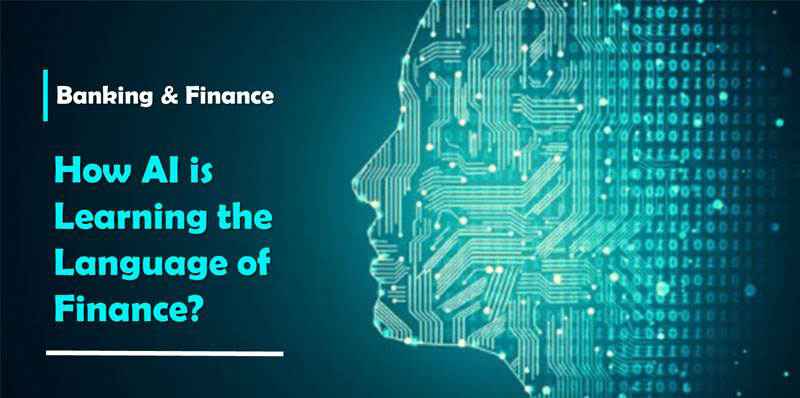How AI is Learning the Language of Finance ?
Updated On : February 2018
Artificial intelligence (AI) is all set to bring about huge changes and benefits to the finance sector in particular. There has been media speculation that with the advent of AI machines will replace humans and leave them with nothing to do. However, the fact is that AI is not going to automate most financial professions but rather will complement human intelligence.
Recently, Google founded the People + AI Research Initiative (PAIR) to better explore these interactions with the support of researchers from MIT. The financial industry has also realised the power and potential that could be yielded by AI. A 2016 report by Ernst & Young, has marked out 5,000 FinTech start-ups, from which a large number are embanking AI onto the banking world.
Easily accessible computing power and machine learning tools have given a boost to cases of machine learning in finance. AI is particularly relevant in the areas of client servicing, trading, post-trade operations such as reconciliations, transaction reporting, tax operation and enterprise risk management. Thus we can safely expect that, in the near future, decision-making processes in banking will be 34% machine generated and 66% by human judgement.
Natural Language Processing (NLP) is a sub-field of AI and is a particularly strong example of applications of augmented intelligence. NLP is the development of systems that become capable of reading and understanding the languages that humans speak. The finance industry is a knowledge-intensive sector and a lot of it requires the reading and understanding of large amounts of information that are only partly structured. However, NLP is making processes much easier, faster and more precise with lesser effort than humans could ever do it at.
Machine learning is revolutionising processes in financial institutions and challenging the some of the older business models. Wealth management companies are using deep learning solutions for long-term value investing, advisors are being replaced by chatbots, covering up to 95% of all queries, and companies like PayPal are able to keep fraud losses below the industry average by scanning transactions largely on artificial neural networks.
Some rapidly growing personal finance apps already have Machine learning, and many major financial service providers are experimenting and trying it out.
Machine-learning powered handling of your personal finances is in its infancy, but the potential is staggering: swapping bank tellers or financial advisers for algorithm-powered chat-bots; fully automated investment services that can move your money through global markets within seconds of financial news; or the ability to instantly access loans based purely on data you've already shared online without realising it.
Let’s look at some examples of machine learning in use today. Some of these applications leverage multiple AI approaches and not exclusively machine learning.
Portfolio Management
The term “Robo-advisor” unheard-of just five years ago, is now a known and common word in the financial landscape. Robo-advisors (companies such as Betterment, Wealthfront, and others) are algorithms built to attune a financial portfolio with the goals and risk tolerance of the user. Users enter their goals (for example, retiring at age 65 with $250,000.00 in savings), age, income, and current financial assets. The advisor (or “allocator”) then spreads investments across asset classes and financial instruments in order to reach the user’s goals. The system then conforms to changes in the user’s goals and to real-time changes in the market, aiming always to find the best fit for the user’s original goals. Robo-advisors have gained significance with millennial consumers who are comfortable investing without a physical advisor and who are less able to validate the fees paid to human advisors.
Algorithmic Trading
Algorithmic trading (sometimes called “Automated Trading Systems,”) has its origins in the 1970’s. It uses complex AI systems to make extremely fast trading decisions. Algorithmic systems often make thousands or millions of trades in a day, hence the term “high-frequency trading” (HFT) is used, which is considered to be a subset of algorithmic trading. Though most hedge funds and financial institutions do not openly disclose their AI approaches to trading, it is believed that machine learning and deep learning are playing an increasingly important role in calibrating trading decisions in real time.
Fraud Detection
The internet today has become friendly and easily accessible, and a huge amount of valuable company data is being stored online. This poses a threat to and is a perfect setup for data security risk. Earlier, financial fraud detection systems were governed by a complex and robust sets of rules, but modern fraud detection actively learns and calibrates to new potential (or real) security threats. Here is where machine learning in finance is useful to detect frauds. Using machine learning, unique activities or behaviours (“anomalies”) are detected and flagged for security teams. With the increasing ways that security can be breached today, genuinely “learning” systems will have to be a necessity in the near future.
Loan / Insurance Underwriting
Underwriting is the perfect job for machine learning in finance, and this could be the one job that machine learning is threatening to replace humans. Especially at large companies (big banks and publicly traded insurance firms), machine learning algorithms can be trained on millions of examples of consumer data and financial lending or insurance results. Algorithms can detect and assess the underlying trends and also detect trends that might influence lending and insuring into the future (are more and more young people in a certain state getting in car accidents? Are there increasing rates of default among a specific demographic population over the last 15 years?). These results, which till now are reserved for larger companies with resources at their disposal, can bring about huge benefits to a company and change their bottom line.


Comments :